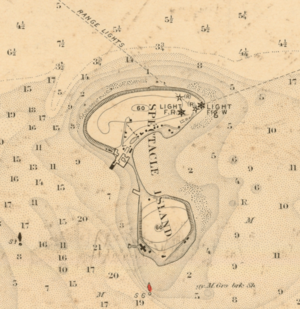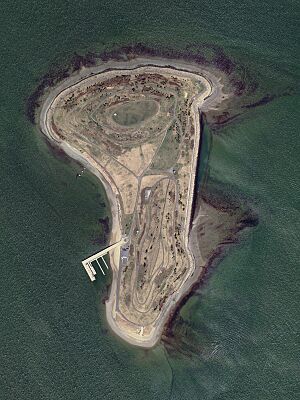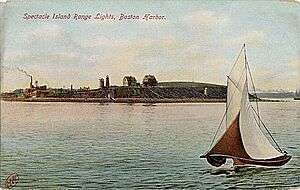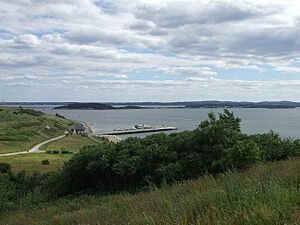Spectacle Island (Massachusetts) facts for kids
Spectacle Island is a cool island in Boston Harbor, about 4 miles (6.4 km) from downtown Boston. It's part of Boston city! This island has a long and interesting past. Today, it's a fun public park with a boat dock, a visitor center, a cafe, a swimming beach with lifeguards, and five miles of walking paths. It's part of the Boston Harbor Islands National Recreation Area. You can get there all year by ferry from Boston, and during summer and on weekends, a shuttle boat connects it to other nearby islands.
Contents
Island Shape: How Spectacle Island Changed
Spectacle Island first looked like two small hills connected by a narrow strip of land. It was about 49 acres (19.8 hectares) big. People think it got its name because it looked like a pair of eyeglasses!
But over time, the island changed a lot. People dumped trash and dirt there. Then, the land was shaped and built up. Now, the island is much bigger, about 85 acres (34.4 hectares). It also has an extra 28 acres (11.3 hectares) of land that shows up at low tide.
Today, the island has two man-made hills. These hills are built with walls and roads, and lots of new plants grow there. Spectacle Island is now one of the highest spots in Boston Harbor, reaching about 157 feet (48 meters) above the sea.
Island's Past: A Look Back in Time
Starting in the early 1800s, Spectacle Island was used because it was far away from Boston. In 1857, a factory that processed animal parts was built there. Later, a city trash burning plant opened, which stayed open until 1935. After that, trash was just dumped on the island for the next thirty years! People even say a bulldozer got swallowed by the trash sometime in the 1950s. The island remained a trash dump until the 1990s.
A Story of Freedom on the Island
In September 1846, Spectacle Island became important in the story of George. George was a person escaping slavery and seeking freedom. He was found hiding on a ship called the Ottoman, which came from New Orleans to Boston Harbor.
The ship's captain, James Hannum, took George to Spectacle Island and kept him under guard. While Captain Hannum stopped at a hotel on the island, George saw his chance! He quickly took Hannum's small boat and headed towards South Boston to escape.
Captain Hannum soon realized George was gone and chased after him by boat and then on foot. After running for two miles through fields and over fences, Hannum caught George just as he reached a bridge. This event made many people in Boston who were against slavery very angry. They even had Captain Hannum arrested for trying to take George back.
Captain Hannum tried to send George back to slavery on another ship. But people who wanted to end slavery stopped Hannum's ship. There was a tense moment at sea, and George's future was uncertain for a while.
Building a New Island
When the huge construction project called the Big Dig started in Boston in 1992, some of the dirt and clay dug up was used to rebuild Spectacle Island. The island was covered with this dirt, then topped with two feet of clay, and finally covered with two to five feet of good soil.
Thousands of trees were planted, and new paths, buildings, and a boat dock were built. In June 2006, Spectacle Island opened to the public. Now it's a fun place for hiking, swimming at the beach, visiting the center with a cafe, and using the marina with 38 boat slips.
Getting to Spectacle Island
You can visit Spectacle Island by taking a ferry from Long Wharf in Boston. If you have your own boat, you can use the island's marina. Ferries also travel between Spectacle Island and Georges Island. The marina was closed for almost two years because of damage from a storm in 2015. But as of July 2017, the marina is open again for visitors!
Spectacle Island in Pop Culture
- Spectacle Island appears in the video game Fallout 4.
- The island is important in the book Zodiac: An Eco-Thriller by author Neal Stephenson.
- Spectacle Island is mentioned in the book The Speckled Monster by Jennifer Lee Carrell. It's described as an island used to keep sick people away from others, especially during the smallpox sickness.
Images for kids













